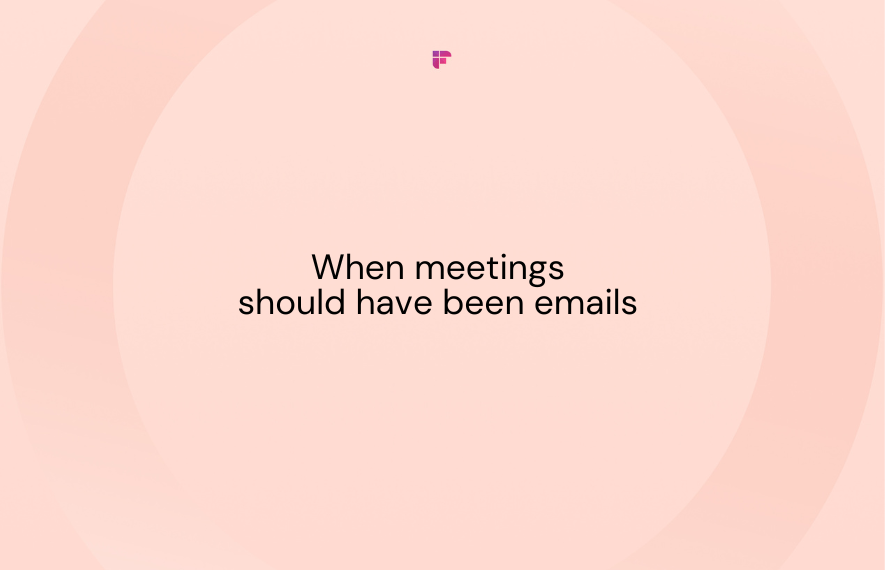
Ah, meetings, the bane of office life.
We've all been there, trapped in a conference room with fluorescent lights humming overhead, a whiteboard that's seen better days, and the palpable sense that time is slipping away, one minute at a time.
What was supposed to be a brief check-in suddenly turns into a deep dive into the minutiae of a project that could have been easily summarized in a brief email.
Professionals often end up grappling with the challenge of maximizing productivity amid a barrage of meetings. And while meetings are great for collaboration and communication, there are instances where they become counterproductive and contribute to a lot of wasted time.
In this blog post, we'll explore six real-life examples of time wastage in meetings and delve into scenarios where emails should most definitely have been the solution.

When to hit pause on meetings
While meetings serve as a platform for collaboration and idea exchange, they can just as easily devolve into time-consuming affairs that hinder productivity. The key lies in recognizing the signs:
- Lack of Clear Agenda: If the agenda resembles a maze with no exit, it might just be an email in disguise.
- Overlapping Information: When the content of a meeting overlaps significantly with routine updates or information already provided through other channels, reconsider the need for a face-to-face gathering.
- One-Way Communication: If the gathering feels more like a monologue than a dialogue, with little room for interaction, an email might serve the purpose better.
1. The status update marathon
We have weekly status updates, requiring a meeting over Zoom that lasts well over the specified 30 minutes. The updates are more exhaustive than necessary. We all end up repeating the same points over and over. ~ Annie
Picture this: Monday morning, everyone gathers for the weekly team meeting. The agenda? Status updates. Team members take the stage one by one, detailing their achievements and setbacks. Before you know it, an hour has passed by. The truth? Most of this information could've been neatly summarized in a well-crafted email.
Not every update requires a face-to-face discussion. Implementing a regular email update system can save valuable meeting time, allowing teams to focus on strategic discussions during their gatherings.

2. The brainstorming black hole
Spontaneous brainstorming sessions where time is wasted because no one has anything to actually share. These short-notice meetings don't give us time to prep. We'd spend an hour awkwardly tossing ideas that usually get shot down because they're not fleshed out at all. ~ Steve
Brainstorming sessions are supposed to be the birthplace of innovation. But imagine this: a room full of blank stares, awkward silences, and the palpable fear of contributing something less than brilliant. What if, instead, we encouraged pre-meeting brainstorming via email?
Individuals could marinate on ideas at their own pace, and when the meeting rolls around, the creative juices are flowing, not struggling to escape the pressure cooker of a group setting.

3. The decision-making dilemma
There are times when members solely want to be heard. Trying to prove their point incessantly when the meeting was supposed to be a discussion. We end up going back and forth tirelessly until we run overtime. The meeting is ultimately rescheduled. ~ Anonymous
Decision-making is the lifeblood of progress, but when discussions drag on endlessly without a consensus in near sight, it's time to reconsider. Endless debates, repeated arguments, and a general sense of confusion are the typical aftermath of a decision-making meeting gone awry. Instead, consider the elegance of email polls. Quick and efficient, everyone gets a say without needing an impromptu debate club.

4. The overly detailed training session
I've found myself sitting through a session that lasted 2 hours with only 10 minutes of relevant info for my department. ~ Joy
Training sessions are vital for skill development, but when they delve into overly detailed information that only concerns a subset of participants, they become time-consuming for others.
Consider a scenario where a training meeting covers topics relevant to only a fraction of the attendees; the instructor passionately explains complex concepts to a sea of bewildered faces. It doesn't have to be this way. On-demand training resources sent via email or accessible through a dedicated platform allow team members to learn at their own pace. No more glazed-over eyes, just focused, efficient learning.

5. The routine check-in ritual
Our check-in meetings have become routine rituals with little substance. There's no discussion; we wait for our turn, report, and then return to work. ~ Mikey
Regular check-ins, the stalwart of team cohesion, can become a tedious routine if not handled with care. If the agenda mirrors individual updates without room for meaningful discussion, it's time to reconsider.
Brief check-in emails can maintain connectivity without dragging everyone into a meeting abyss. This allows team members to stay informed without dedicating valuable time to a meeting that adds minimal value.

6. The emergency meeting meltdown
We all know that calling for an emergency meeting within 5 minutes of the supposed 'emergency' never really works. Yet we do it every single time. ~ Community Contributor
Urgency is a fact of professional life, but a last-minute emergency meeting? It's a productivity killer. Imagine the chaos of gathering everyone at a moment's notice without a clear agenda. It's the workplace equivalent of herding cats. Instead, emergency communication protocols, like a well-crafted email, ensure everyone is on the same page without inducing panic.

Streamlining communication for optimal efficiency

Streamlining meetings for optimal efficiency is but a necessity in today's dynamic work environment. Here's how you can do just that.
- Implement a robust email update system: Establish a regular email update system where team members share progress, plans, and challenges to ensure meetings focus on strategic discussions and problem-solving.
- Encourage pre-meeting preparation: Before brainstorming or decision-making meetings, encourage participants to prepare by researching and formulating their ideas so that the meeting is productive and focused on generating innovative solutions.
- Leverage asynchronous communication: Consider asynchronous communication methods like email or collaborative online platforms for decision-making and feedback. This allows team members to contribute at their convenience, streamlining the decision-making process.

- Provide on-demand training resources: Instead of lengthy training sessions, provide on-demand training resources through email or a dedicated platform so team members can access information as needed, promoting self-directed learning.
- Opt for brief check-in emails: Consider replacing meetings with brief check-in emails for routine check-ins to ensure everyone stays informed without dedicating unnecessary time to a meeting.
- Establish emergency communication protocols: In emergency situations, have predefined communication protocols in place. This might involve sending urgent information through email or a designated communication channel for quick updates.

Master your meetings with Fireflies.ai

If you've ever found yourself drowning in a sea of meeting minutes, struggling to recall action items, or wondering if you could've put that time to better use, you're not alone. But fear not; Fireflies.ai has your back in the battle against meeting-related time wastage. It's your intelligent assistant designed to tackle your meeting-shaped challenges.
Automating note-taking
One of the biggest culprits of meeting inefficiency? The tedious note-taking process. Juggling between listening attentively and capturing key points can feel like a circus act. Here's where Fireflies steps in, gracefully taking the note-taking burden off your shoulders. With its intelligent automation, Fireflies captures crucial details, including key points, action items, and discussions. No more frantic scribbling or multitasking madness.

From chaos to clarity
Imagine a world where your meetings are more than just a blur of words and numbers. Fireflies transforms the chaos of discussions into concise and actionable summaries. It sifts through the chatter, distilling the essence of your meetings into digestible insights. You can customize these summaries to get only the most relevant meeting intel. This saves you from drowning in unnecessary details and ensures that everyone leaves the meeting on the same page.

Reducing the risk of time wastage
How often have you walked out of a meeting wondering, "What did we even accomplish?" Fireflies minimizes the risk of time wastage by providing clarity and structure to your discussions. No more sifting through endless notes or struggling to recall decisions made in the heat of the meeting. With Fireflies, your meetings become focused, purposeful, and, dare we say it, enjoyable.
Make the Most of Your Meetings with Fireflies AI
By automating note-taking, Fireflies liberates you to fully engage in discussions, contribute your insights, and collaborate without the fear of missing crucial details. Your time is valuable, and Fireflies is here to ensure that every minute spent in a meeting is a minute well-spent.
Try Fireflies for free!Conclusion
While meetings foster collaboration, efficiency demands a discerning eye. It's not about eradicating meetings altogether but recognizing when the power of the inbox can save the day. So, the next time you feel the gravitational pull of a meeting, ask yourself: "Could this have been an email?" Your productivity and the collective sanity of your team might just thank you for it.






